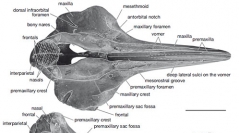

 Geodiversitas
29 (4) - Pages 561-618
Geodiversitas
29 (4) - Pages 561-618Eight new genera and 10 new species of fossil beaked whales (Cetacea, Odontoceti, Ziphiidae) are described on the basis of cranial material recovered by trawling from the sea floor off South Africa. Although no exact stratigraphic information is known for these fossils, most are strongly phosphoritised (some even have phosphorite concretions attached), indicating that their fossilization could be related to one or more of the phosphogenic episodes that occurred in the South African coastal waters since the latest Oligocene. Considering the main phosphogenic epochs and the evolutionary level of the majority of the ziphiids here described, a middle-late Miocene age may be suggested for most, but not all, of these fossils. The new genera named here more than double the known diversity of the fossil beaked whales and represent more than one third of the total diversity of this family (fossil and extant). A parsimony analysis within the family including the Recent taxa reveals that some of the new fossil taxa belong to three extant subfamilies redefined here, while the others are outside these subfamilies; this indicates the presence in the past of some ziphiid lineages now extinct. In detail, Microberardius africanus n. gen., n. sp. is placed in the subfamily Berardiinae together with the Recent Berardius; Izikoziphius rossi n. gen., n. sp. and I. angustus n. gen., n. sp. are related to the Recent Ziphius inside the subfamily Ziphiinae and Khoikhoicetus agulhasis n. gen., n. sp., Ihlengesi saldanhae n. gen., n. sp., and Africanacetus ceratopsis n. gen., n. sp. belong to the Hyperoodontinae together with the Recent Hyperoodon, Mesoplodon, and Indopacetus. However, Nenga meganasalis n. gen., n. sp., Pterocetus benguelae n. gen., n. sp., and Xhosacetus hendeysi n. gen., n. sp., together with the Recent Tasmacetus, do not fit in any of the three subfamilies mentioned above. Taking into account the high number of unnamed fragmentary specimens, the fossil taxa listed above, together with Mesoplodon slangkopi n. sp. and Ziphius sp., probably represent only a part of the South African fossil ziphiid fauna(s), revealing an unexpected high diversity for the previously poorly known southern hemisphere fossil beaked whales. Such a high ziphiid diversity might be locally related to the upwelling system and resulting high productivity linked to the northward running cool oceanic Benguela Current entering the shallower waters along the south-west coast of South Africa and Namibia since the middle Miocene.
Mammalia, Cetacea, Odontoceti, Ziphiidae, beaked whales, Berardiinae, Hyperoodontinae, Ziphiinae, fossil, Neogene, Miocene, South Africa, phylogeny, phosphorites